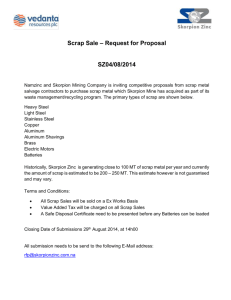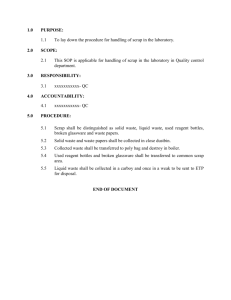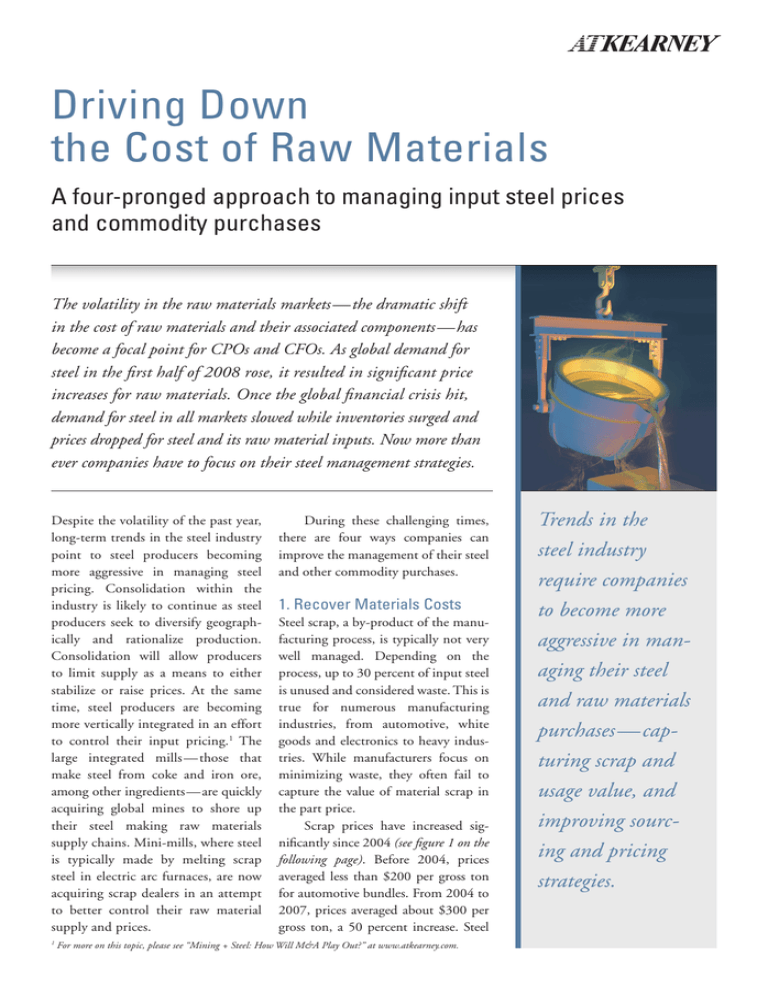
Driving Down
the Cost of Raw Materials
A four-pronged approach to managing input steel prices
and commodity purchases
The volatility in the raw materials markets—the dramatic shift
in the cost of raw materials and their associated components—has
become a focal point for CPOs and CFOs. As global demand for
steel in the first half of 2008 rose, it resulted in significant price
increases for raw materials. Once the global financial crisis hit,
demand for steel in all markets slowed while inventories surged and
prices dropped for steel and its raw material inputs. Now more than
ever companies have to focus on their steel management strategies.
Despite the volatility of the past year,
long-term trends in the steel industry
point to steel producers becoming
more aggressive in managing steel
pricing. Consolidation within the
industry is likely to continue as steel
producers seek to diversify geographically and rationalize production.
Consolidation will allow producers
to limit supply as a means to either
stabilize or raise prices. At the same
time, steel producers are becoming
more vertically integrated in an effort
to control their input pricing.1 The
large integrated mills — those that
make steel from coke and iron ore,
among other ingredients—are quickly
acquiring global mines to shore up
their steel making raw materials
supply chains. Mini-mills, where steel
is typically made by melting scrap
steel in electric arc furnaces, are now
acquiring scrap dealers in an attempt
to better control their raw material
supply and prices.
1
During these challenging times,
there are four ways companies can
improve the management of their steel
and other commodity purchases.
1. Recover Materials Costs
Steel scrap, a by-product of the manufacturing process, is typically not very
well managed. Depending on the
process, up to 30 percent of input steel
is unused and considered waste. This is
true for numerous manufacturing
industries, from automotive, white
goods and electronics to heavy industries. While manufacturers focus on
minimizing waste, they often fail to
capture the value of material scrap in
the part price.
Scrap prices have increased significantly since 2004 (see figure 1 on the
following page). Before 2004, prices
averaged less than $200 per gross ton
for automotive bundles. From 2004 to
2007, prices averaged about $300 per
gross ton, a 50 percent increase. Steel
For more on this topic, please see “Mining + Steel: How Will M&A Play Out?” at www.atkearney.com.
Trends in the
steel industry
require companies
to become more
aggressive in managing their steel
and raw materials
purchases — capturing scrap and
usage value, and
improving sourcing and pricing
strategies.
FIGURE 1: Steel scrap pricing per automotive bundle
costs by 5 to 8 percent. For example,
if steel or material accounts for 35
to 50 percent of the total part price,
a 5 to 8 percent improvement in
material costs would equate to a piece
part savings of 2 to 4 percent.2
Price by gross ton ($US)
$1,000
<$800
$800
$600
$400
2. Increase Sourcing Power
<$300
<$200
$200
$0
Jan. ‘04
Jan. ‘05
Jan. ‘06
Jan. ‘07
Jan. ‘08
Jan. ‘09
Sources: American Metals Market, A.T. Kearney analysis
scrap prices peaked in July 2008 at more
than $800 per gross ton before dropping back to the 2004 to 2007 average.
Although steel scrap prices have
been depressed recently, the long-term
outlook has prices becoming more
volatile and trending higher. Yet with
limited visibility into the value of
scrap materials accounted for the part
prices, companies are often unable to
address this cost. When the price of raw
materials rises, this becomes a virtual
price increase from parts suppliers.
Companies that account for
scrap material value in the component price can reduce their material
FIGURE 2: A future-state sourcing model consolidates service centers
Company
Aggregate requisitions
and negotiate supply
agreements
Service
center
Financial
transactions
Processing
Steel mills
Direct mill
shipments
JIT shipments
from service
centers
Suppliers
*JIT is just-in-time
Source: A.T. Kearney analysis
2
The equation: 5 percent x 35 percent = ~2 percent and 8 percent x 50 percent = ~4 percent.
In a traditional supply chain, as suppliers purchase materials they typically
focus exclusively on their internal businesses, which are not always large
enough to negotiate directly with large
entities, such as steel mills. Therefore,
steel is often purchased from an intermediary, such as a steel service center,
resulting in an extended supply chain
that includes numerous service centers
and different pricing levels for each
steel grade.
It is possible to improve negotiation leverage and reduce costs by gaining more visibility and control over the
material supply chain—specifically,
by optimizing the material purchased
directly from the large steel mills and
the material provided through service
centers. The idea is to implement a
leveraged sourcing model focusing on
a few key parameters (see figure 2).
The first step is to assemble a consolidated package of the steel buy
(volume by grade, gauges and sizes,
among others) that includes steel purchased by the company and its large
Tier I suppliers directly from the mills,
and steel purchased from service centers of the smaller Tier I and Tier II
suppliers. This allows consolidation
and elimination of different material
specifications, gauges and sizes.
As the steel buy is being defined,
a detailed understanding of the operating capabilities of the various steel
mills will help take advantage of oper-
ational efficiencies at each mill (economical sizes and sheet thickness).
It is important to negotiate total cost
rather than just base price and to avoid
additional costs such as surcharges.
Ideally, negotiations concern everything that feeds into the total cost,
including raw material inputs, transportation and energy.
Optimizing the
purchasing of materials will improve
negotiation leverage
and reduce costs.
With the steel price set, the focus
can shift to materials provided through
service centers. As figure 2 shows, the
goal is to consolidate the number of
service centers providing materials.
Because the base steel price has been
negotiated with the mills, selection
and negotiations should focus on value
add, freight and service levels, and
ensuring inventory levels and services.
This model can result in significant savings. Our clients achieved
from 8 to 15 percent savings on the
cost of steel. If steel accounts for 35 to
50 percent of the piece part price, this
equates to direct material savings of
3 to 8 percent.
3. Optimize Materials Usage
The third component of our strategy
focuses on reducing costs through tech-
nical improvements, including reducing complexity, shrinking part-design
costs, and segmenting suppliers.
Reduce complexity. To reduce
complexity, the focus naturally turns
to a portfolio rationalization to reduce
specifications, such as gauges and
grades, and then implementing processes to prevent re-proliferation. This
requires getting engineers and designers aboard early to understand the cost
impact of deviating from preferred
specifications. In the electronics industry, as an example, this might include
a cost-benefit analysis of standard
versus non-standard thickness for
printed circuit boards.
Shrink part-design costs. Reducing part-design costs begins with collaborative design reviews with internal
and supplier engineering teams to evaluate all parameters that affect material
costs and utilization. Competitive
benchmarking and reexamining the
manufacturing process will ensure that
maximum benefits are achieved
Segment suppliers. When sourcing parts, it makes financial sense to
consider material specifications and
sizes. For example, sourcing parts that
use the same grades or gauges to the
same supplier allows for nesting parts
more effectively.
Typical results from focusing on
material usage: 5 to 8 percent direct
material savings.
4. Manage the Materials
Supply Chain
A supply chain materials management
strategy employs material scrap generated by manufacturing processes —
both internally and externally—within
the supply chain.
The goal is to create a closed-loop
network whereby the company uses the
scrap dealer for processing and transportation and sells scrap directly to a
scrap-consuming supplier (see figure 3).
We can use the aerospace industry to illustrate this point. Aerospace
parts have high purchase-to-fly ratios,
commonly 8 to 12:1. For every 1 lb. of
material in a part, 8 to 12 lbs. of raw
material has to be purchased due to
the reduction that occurs during the
manufacturing process. The industry
has scrap revert programs, including
right-to-buy agreements for supplierproduced scrap. Lean principles and
FIGURE 3: A closed-loop scrap network
Scrap
from supplier
plant
Company
scrap management group
Scrap flow
Financial transaction
Scrap
consuming
supplier
Scrap
from company
plant
Source: A.T. Kearney analysis
Scrap
dealer
Scrap Management
Even if a company’s scrap network is not large enough to create a closed-loop system,
there are three ways to improve savings potential by managing scrap throughout the
supply chain.
Evaluate best prices. Determine the best price for scrap by renegotiating based
on a better understanding of competitive market prices and types of scrap being generated (through a scrap surcharge evaluation). Are we paying true market price? Make
sure all additional costs are based on the true market price for the grades used.
Concentrate scrap volumes. Better pricing can be achieved by consolidating
dealers, pooling scrap volume across facilities in a region, and redistributing volume
among scrap dealers.
Optimize product specifications. Using materials with the least-cost specifications requires investigating specifications to identify potential to use substitute or
lower grade materials.
best practices improve the recovery.
Scrap collection, along with inbound
freight and quality assurance of scrap
produced, is then used as leverage
when negotiating raw material contracts with mills. In doing so, the aero-
space industry not only reduces its raw
material acquisition costs, but also
reduces lead times.
Although determining market
price for material scrap includes
acquisition costs, transportation, pro-
cessing and margins, most companies
do not know if they are getting “fair”
market price. Unbundling these costs
offers transparency into these costs
and removes a margin layer. Indeed,
supply chain material management
can reduce the overall cost of finished
products by 2 to 5 percent (see sidebar:
Scrap Management).
Get Aggressive
Given the volatility and price increases
in the raw materials markets, companies are renewing their focus on the
raw materials supply chain, primarily
steel and commodity purchases—
recovering materials costs, improving
sourcing, and utilizing steel scrap
throughout the value chain. Longterm trends in the industry will require
a more aggressive stance in managing
pricing—now more than ever.
Authors
Bill Windle is a partner in the firm’s automotive practice. Based in the Detroit office, he can be reached
at bill.windle@atkearney.com.
Michael Mazur is a principal in the firm’s automotive practice. Based in the Detroit office, he can be reached
at michael.mazur@atkearney.com.
David Lamb is a consultant in the Detriot office. He can be reached at david.lamb@atkearney.com.
Eric Gierahn is a consultant in the Detroit office. He can be reached at eric.gierahn@atkearney.com.
Kevin Krot is a consultant in the Detroit office. He can be reached at kevin.krot@atkearney.com.
A.T. Kearney is a global management consulting firm that uses strategic insight,
tailored solutions and a collaborative working style to help clients achieve sustainable
results. Since 1926, we have been trusted advisors on CEO-agenda issues to the
world’s leading corporations across all major industries. A.T. Kearney’s offices are
located in major business centers in 37 countries.
A.T. Kearney, Inc.
Marketing & Communications
222 West Adams Street
Chicago, Illinois 60606 U.S.A.
1 312 648 0111
email: insight@atkearney.com
www.atkearney.com
Copyright 2010, A.T. Kearney, Inc. All rights reserved. No part of this work may be reproduced in any form without written permission from the copyright holder.
A.T. Kearney® is a registered mark of A.T. Kearney, Inc. A.T. Kearney, Inc. is an equal opportunity employer. 3-10

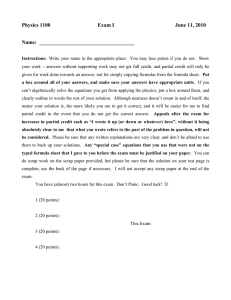
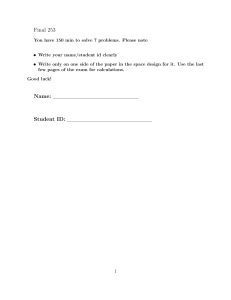
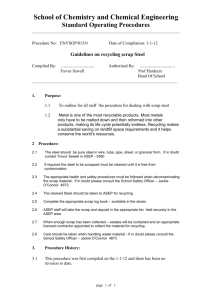
![You`re invited to celebrate [child`s name]`s birthday at SCRAP! What](http://s3.studylib.net/store/data/007177272_1-c15601fb9e11b26854f13f1982e634e8-300x300.png)
